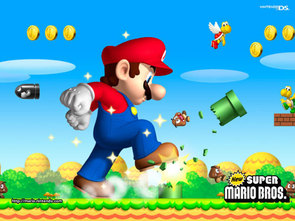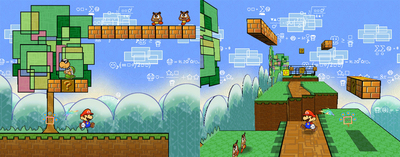2D + 2D = 3D pt.2
 Monday, February 23, 2009 at 9:35PM
Monday, February 23, 2009 at 9:35PM In part 1 of this series, I covered some of the design features and conventions that are commonly found in 2D side-scrolling and 2D top down games. Before I get into 3D games, I wanted to go over several examples of each type of 2D in addition to highlighting a few special cases.
Examples 2D Side-Scrolling
The Super Mario Bros games use the side perspective and gravity. This is what makes them platforming games. Mario's JUMP mechanic is so fined tuned, that simply JUMPing is interesting and engaging. It takes very little to influence the player to jump. A lone Goomba walking along is enough to force the player to take action. For these reasons, the 2D Mario platforming series features some of the most simple and effective enemies, level design, and gameplay.
- Super Mario Bros.
- Super Mario Bros. 2
- Super Mario Bros. 3
- Super Mario World
- New Super Mario Brothers
It's common for Samus to gain greater and greater platforming abilities as players progress through the Metroid games. Before Samus gains super powers, the game is designed to play to a simple dynami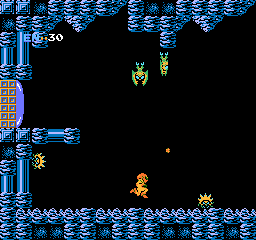 c created by gravity. Because Samus has a gun, the easiest directions for players to aim and shoot are directly in front, above, or on one of the diagonals (depending on the Metroid game). To keep things interesting for the player, Metroid is designed with enemies that are positioned in the player's "blind spots." Basically, these blind spots are areas that exist in between the easy aiming zones. To hit targets in one's blind spot, players have to move around until the target is positioned outside of the blind spot. The Metroid series uses the gravity dynamic by designing the terrain and enemies in such a way that players have to JUMP and use the platforms in the environment to effectively hit targets.
c created by gravity. Because Samus has a gun, the easiest directions for players to aim and shoot are directly in front, above, or on one of the diagonals (depending on the Metroid game). To keep things interesting for the player, Metroid is designed with enemies that are positioned in the player's "blind spots." Basically, these blind spots are areas that exist in between the easy aiming zones. To hit targets in one's blind spot, players have to move around until the target is positioned outside of the blind spot. The Metroid series uses the gravity dynamic by designing the terrain and enemies in such a way that players have to JUMP and use the platforms in the environment to effectively hit targets.
- Metroid
- Metroid 2
- Super Metroid
- Metroid Fusion
- Metroid Zero Mission
The Mega Man games use the 2D perspective and gravity in a similar way the Metroid series. Unlike Samus, Mega Man can only fire straight ahead of him. Basically, Mega Man's blind spot is an area that extends horizontally from his head to the top of the screen. Even though guns can easily have a variety of negative effects on the design of a game, this aiming limitation forces players to JUMP, SLIDE, and/or DASH about to hit targets. Like in Super Mario Brothers, the enemies are arranged in places so that Mega Man can reach the same horizontal plane thus focusing the gameplay.
- Mega Man 1-9
- Mega Man X series
- Mega Man Zero series
- Mega Man ZX
- World of Goo: Bridge building doesn't exist without gravity. The developers kept things relatively simple by designing the game world in 2D. From this point, the only 2D perspective that displays gravity most clearly is the side perspective. Along with gravity, World of Goo factors weight, momentum, and other physics interactions.
- Tetris Attack/Planet Puzzle League: Since the original Tetris, many puzzle games use the 2D side perspective and gravity to present clear yet dynamic challenges.
- Spelunky: This game's design is very Classical, using gravity to focus the gameplay and create a key dynamic.
Examples 2D Top Down
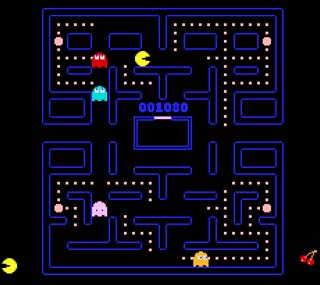
- Pac Man: This classic arcade game uses level elements (walls) to create hallways that funnel the player and enemies. The 4 ghost enemy elements are designed with a kind of pathfinding AI to challenge the player as he/she attempts to eat all the pellets in the level. The 4 ghosts also have distinct personalities that affect their movement throughout the level; chaser, ambusher, fickle, stupid. These personalities were designed to keep the game from becoming too hard because of the ghosts, and to prevent the game from becoming too boring. You can read more about it here. For these reasons, the enemies in Pac Man feature a lot of subtle and hidden complexities. You can play a free internet version of Pac Man here.
- Geometry Wars: This game is the best example of how strained the core design of a game can become when the only significant elements of contrary motion against the player are enemy elements. Not only does Geometry Wars support a screen full of enemies, but the player can shoot and infinite supply of bullets that nearly fill the screen. This game relies heavily on pathfinding enemy AI to create the challenge. Also, the enemy sprites/models frequently overlap with each other. Because of the top down perspective, we tend to interpret this as the enemies existing at different heights.
Since The Legend of Zelda on the NES, enemies in the top down Zelda games have been designed to utilize more advanced pathfinding. From the simple River Zora on the NES, the flying tiles on the SNES, to the Phantoms in the Temple of the Ocean King on the DS, this evolution in enemy design still influences the player by restricting space while, but at the same time reduces the amount of enemies on the screen and the complexity of the enemy design.
- The Legend of Zelda
- A Link To The Past
- Phantom Hourglass
- Star Craft: I can't think of an RTS that doesn't heavily use path finding. From the probes that can automatically find a clear space to harvest nearby minerals and then transport the minerals to the Nexus to the fast flying Interceptors launched from Carriers, just about every attack and unit in Star Craft can accurately its way to its target. The maps in Star Craft are too large with too much space to cover to baby sit every unit along. If there wasn't pathfinding in Star Craft, the game would simply fall apart.
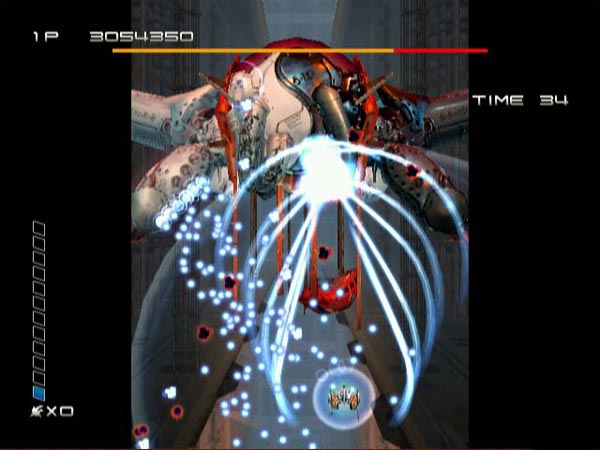
- Ikaruga: In this masterful top down shooter by Treasure, players must survive enemy attacks that fill the screen with slow moving bullets. This is an example of how top down games often use mass numbers to restrict movement of the large, open spaces. Top down shooters typically don't feature any level elements. In most of these games, touching a wall or any other solid structure is deadly. Though Ikaruga does feature a few true/safe level elements, for the most part, the contrary motion is created by the enemy units and their bullet fire. Fortunately, all of the bullets in Ikaruga are polarized into white or black energy. Not only can the player absorb bullets when their ship is of the same color, but switching back and forth between ship polarity inverts the safe-dangerous areas on the screen. Additionally, in the normal and hard modes, enemies release a spray of bullets that move in random directions when destroyed. In this way, as the player moves around switching from offense to defense, the movement becomes increasingly engaging and dynamic along with the interplay (gunplay). Finally, the MISSILE mechanic homes in on enemies using pathfinding.
- Though the ship model looks round, the actual hit box for it is much smaller than the model. Sometimes, bullets and objects appear to pass through the sides of the ship without causing damage. Because height is interpreted in 2D top down games, we think of these occurrences as near collisions.
- Neo*RPG: (variation) (interplay) The player movement and enemy movement are all designed around pathfinding. When approaching the player, the enemies will smoothly adjust their course even as the player moves about. The enemy type that throws rocks from afar will always aim at the player's exact position. Additionally, the rocks from these enemies pass through other enemies as they travel across the screen yet the rocks will interact with walls, blocks, and the player. Because the perspective is top down and in 2D, we interpret this property as the rock projectile flying over the enemies. In this way, the enemy rock projectiles don't necessarily go against form fits function.
Special Examples
- These Zelda games work in the same way as the down top Zelda games listed above do with one key exception. There are specific areas in these games that switch to a 2D side-scrolling perspective. During these parts, Link's JUMP ability gained from Rok's Feather functions like Mario's JUMP in his 2D platformers. These 2D Zelda sections even have Goomba as enemies.
- Here's where things get really interesting as far as 2D interpretation goes. The sprite for Link in the top down section is the same as for the side-scrolling section. Somehow, our brains interpret Link as standing upright regardless of the perspective of the world around Link.
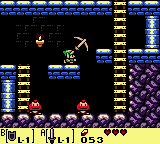
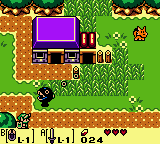
- Link's Awakening:
- Four Swords
- Bionic Commando Rearmed: This retro evolved game features bonus stages with a top down perspective. The gameplay in these sections drops significantly because of the lack of a gravity dynamic due to the bionic arm platforming.
The gimmick of the following games involves manipulating perspective. These game designers realized that there's a significant amount of interpretation involved with the 2D perspective and that this zone of interpretation can be used to trick, obscure, and hide elements from the player. Playing these games well requires the player to consider the game world as a set of clear rules that are stressed differently depending on the perspective. The player must constantly be aware that all isn't as it seems.
- Bangio-O Spirits: This action game power house plays like a top down shooter and a side scroller at the same time. The player is bound by gravity, but only partially. With the ability to MOVE, FLY, and BOOST in all 8 directions indefinately as well as hover in place, gravity isn't a core dynamic of the player's motion. In addition to the player's freedom of motion, the enemies can move around freely and attack using a signicant amount of pathfinding. It is not uncommon to find levels in this game that are filled with enemies that fill the screen with bullets. After all, with so much free space to move around in, the enemies have to be able to pressure the player somehow. This design makes Bangai-O functionally like a top down shooter.
- On the other hand, boxes, blocks, and other objects are affected by gravity. Some levels are specifically design so that players have to juggle and adjust their strategies according to falling objects. Depending on the level design, Bangai-O spirits can play more like a side-scroller or a top down game.
- Rom Check Fail: (video) This quirky and free indie game is perfect for experiencing the dynamics of side-scrolling and top down gameplay. Every couple of seconds or so, the enemy, player, and level elements get scramble around randomly choosing from a pool of old, classic 8 bit games. Among the classic games are The Legend of Zelda, Super Mario Brothers, Spy Hunter, Space Invaders, Asteroids, and Pac Man. I highly recommend giving it a try. Be sure to pay attention to how your brain processes the change between side-scrolling and top down gameplay. You can find it here.
To finish off part 2 of this series and to preface our look at real 3D games, I recommend playing through this "evolution" of pong as it moves from 2D to 2D to 3D.
- CLASSIC: Top down (no gravity) 1D player movement.
- SLIME BALL: Side-Scroller (gravity) 2D player movement.
- 3D PONG: 3D play field (no gravity) 2D player movement. 3D ball movement.


